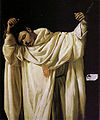
Saint Serapion (Zurbarán)
Encyclopedia

Francisco Zurbarán
Francisco de Zurbarán was a Spanish painter. He is known primarily for his religious paintings depicting monks, nuns, and martyrs, and for his still-lifes...
(1598–1664). The work was commissioned by the The Mercedarian Order
Order of the Blessed Virgin Mary of Mercy
The Royal, Celestial and Military Order of Our Lady of Mercy and the Redemption of the Captives also known as Our Lady of Ransom is a Roman Catholic religious order established in 1218 by St...
to hang in the De Profundis (funerary chapel) hall of their monastery in Seville
Seville
Seville is the artistic, historic, cultural, and financial capital of southern Spain. It is the capital of the autonomous community of Andalusia and of the province of Seville. It is situated on the plain of the River Guadalquivir, with an average elevation of above sea level...
. Zurbarán is noted for his portrayals of penitent or martyred monks and saints, and this work draws a comparison from critic Tom Lubbock to the Jesuit priest and martyr Saint Edmund Campion
Edmund Campion
Saint Edmund Campion, S.J. was an English Roman Catholic martyr and Jesuit priest. While conducting an underground ministry in officially Protestant England, Campion was arrested by priest hunters. Convicted of high treason by a kangaroo court, he was hanged, drawn and quartered at Tyburn...
(1540–1581) who was publicly hanged, drawn and quartered
Hanged, drawn and quartered
To be hanged, drawn and quartered was from 1351 a penalty in England for men convicted of high treason, although the ritual was first recorded during the reigns of King Henry III and his successor, Edward I...
in London in December 1581. The art critic draws comparison between Campion and Saint Serapion of Algiers
Serapion of Algiers
Saint Serapion of Algiers was a Mercedarian friar who is venerated as a martyr by the Catholic Church, and as a proto-martyr by the Mercedarian Order...
(1179–1240), a Mercedarian friar
Friar
A friar is a member of one of the mendicant orders.-Friars and monks:...
who fought in the Third Crusade
Third Crusade
The Third Crusade , also known as the Kings' Crusade, was an attempt by European leaders to reconquer the Holy Land from Saladin...
of 1196 and was later martyred.
Saint Serapion is depicted by Zurbarán in a quasi-crucified pose, standing with each hand bound by ropes and chain to an overhead horizontal pole. According to Michael Brenson of the New York Times, his head "has shifted from the realm of the robe to the realm of the cape, which supports the head and seems to have the potential to lift it to the sky". The painting stops at the figure's knee level, while the strain placed on his arms is indicated by the heavy hanging folds of the drapes of the cloth hanging from left shoulder and right outstretched arm. The saint is identified by text on a small note placed to the left of his chest area.
The work makes strong use of chiaroscuro
Chiaroscuro
Chiaroscuro in art is "an Italian term which literally means 'light-dark'. In paintings the description refers to clear tonal contrasts which are often used to suggest the volume and modelling of the subjects depicted"....
in the Spanish Tenebrist tradition of Jusepe de Ribera. The dominance of the white paint used to render the cloth creates a sense of tranquility, while the tension of the painting is derived from the dark shade created from the deep folds of the robes. In 2003, Scottish painter Alison Watt wrote, "Each fold has been pared down to the basic elements of light and shade. As a viewer you are seduced by this simplicity, only to realise you have been duped. Zurbaran has elevated the humble fabric of the robes of Saint Serapion to a divine level with pure, magnificent white."
There is an allusion to Zurburán's depiction of Saint Serapion in the poem "Meditations in an Emergency" by the mid-twentieth century American poet Frank O'Hara
Frank O'Hara
Francis Russell "Frank" O'Hara was an American writer, poet and art critic. He was a member of the New York School of poetry.-Life:...
:
- St. Serapion, I wrap myself in the robes of your whiteness which is like midnight in Dostoevsky.'

